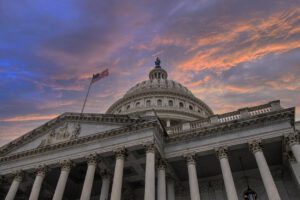If you’re exploring your college financing options, you know two things. The first is that college is expensive, and even the most financially prepared families have to consider all of their resources when tackling the bottom line. The second is that student loans are a common tool for financing a college education, and the federal government is the leading source of loans. In fact, federal student loans make up about 92% of the total education financing market.
Federal law sets the interest rate on federal student loans, and the rates are updated each year. Historically, federal student loans had relatively low rates — rates were under 4% as recently as 2023 — but with changing economic conditions, rates have fluctuated.
At the end of May, the rates for the 2025-2026 academic year were announced and, true to the majority of predictions, saw a rate dip. However, the change is small; they’re still much higher than usual.
Here’s what you should know about the new rates, and how they may affect you as a borrower.
New Federal Student Loan Interest Rates
Typically, the new rates are announced in mid-May, and this year the official announcement from the U.S. Department of Education was released May 30, 2025.
For Direct Subsidized and Direct Unsubsidized Loans for undergraduate borrowers, the rates will decrease from 6.53% to 6.39%. For Direct Unsubsidized loans for graduate or professional borrowers, the rates will decrease from 8.08% to 7.94%. And, for Parent and Grad PLUS Loans — who are taken out by parents and graduate or professional students — the rates will decrease from 9.08% to 8.94%.
| Direct Subsidized | Direct Unsubsidized | Direct Unsubsidized | Parent and Grad PLUS | |
| Borrower Type | Undergraduate | Undergraduate | Graduate | Parents and graduate students |
| Rate for Loans Disbursed July 1, 2025, through June 30, 2026 | 6.39% | 6.39% | 7.94% | 8.94% |
| Rate for Loans Disbursed July 1, 2024, through June 30, 2025 | 6.53% | 6.53% | 8.08% | 9.08 |
| Rate for Loans Disbursed July 1, 2023, through June 30, 2024 | 5.50% | 5.50% | 7.05% | 8.08% |
| Rate for Loans Disbursed July 1, 2022, through June 30, 2023 | 4.99% | 4.99% | 7.05% | |
| Rate for Loans Disbursed July 1, 2021, through June 30, 2022 | 3.73% | 3.73% | 5.28% | 6.28% |
| Rate for Loans Disbursed July 1, 2020, through June 30, 2021 | 2.75% | 2.75% | 4.30% | 5.30% |
| Average Rate on Loans Issued between July 1, 2020, and June 30, 2026 | 4.98% | 4.98% | 6.53% | 7.53% |
Even with the rate decrease, federal student loan interest rates are surprisingly high right now. Historically, federal loans have relatively low rates; just a few years ago, the rate on undergraduate student loans was just 2.75%, so today’s rates are significantly higher.
What the New Rates Mean for Borrowers
After several steep rate increases over the past few years, a rate reduction is a welcome change for borrowers. However, the change only affects new student loans; the new rates only apply to loans taken out between July 1, 2025, and June 30, 2026.
If you have existing loans, the interest rates on your loans are unchanged. Federal loan rates are set for the life of the loan, so the rate only affects new loans. That’s why if you take out federal loans over several years — for example, taking out a new Direct Unsubsidized loan for every year you’re in college — you could have loans with different rates.
The rate on federal loans has a major impact on your repayment, affecting how much interest accrues and your total repayment cost.
For example, say you took out $5,000 in unsubsidized loans at 2.75%. With a 10-year repayment term, your monthly payment amount would be $47.71, and you’d repay a total of $5,724.66 over the life of your loan.
If you took out that same amount at the new rate of 6.39%, your monthly payment would be $56.49, and you’d repay a total of $6,779.35. With the higher rate, you’d pay over $1,000 more in interest.
| Unsubsidized Loan at 2.75% | Unsubsidized Loan at 6.39% | |
| Principal | $5,000 | $5,000 |
| Loan Term | 120 months | 120 months |
| Monthly Payment | $47.71 | $56.49 |
| Total Interest | $724.66 | $1,779.35 |
| Total Repaid | $5,724.66 | $6,779.35 |
Understanding the Total Cost of Your Loan
Student loan rates are one of the most significant factors when determining which loan type is right for you. Another is fees, which can quickly add up depending on the source of the loan and how many loans you may need to cover the cost of a college education.
Costs can vary by loan type — federal or private — and lender. In general, you can expect the following costs with most student loans:
- Annual Percentage Rate (APR) – The loan APR is the rate of interest you’ll pay on the loan in a year, represented as a percentage. Federal loans have fixed interest rates. Private loans can have fixed or variable rates.
- Origination or Disbursement Fees – Federal loans and some private student loans may involve origination or disbursement fees. These fees are usually taken from the total loan amount before the funds are disbursed to the borrower. For example, if you take out a $10,000 loan with a 2% disbursement fee, you’d only receive $9,800, but you’d pay interest and have to repay the principal amount of $10,000. Currenly, federal disbursement fees average between 1 and 4%. ELFI, however, has no application or origination fees.
In addition to the cost of borrowing, you should be aware of the costs should you not be able to meet your repayment obligations.
- Late Payment Fees – If you miss a payment with your student loans, you may be charged a fee per late payment. The amount — either a flat fee or a percentage of the unpaid amount — varies by loan type and lender.
- Collection Costs – If you enter into default, the lender may send your account to collections, meaning a collections agency will take over efforts on collecting payments. Collections agencies can be aggressive and persistent and, to reconcile your debt, you usually will have to pay a fee to cover the collections agency’s expenses on top of the principal and interest.
Previously, some student loans had prepayment penalties, or fees for paying off the loan ahead of schedule. However, the Higher Education Act of 2008 barred lenders from charging prepayment penalties.
Paying for College: Evaluate All of Your Options
Federal loans are smart lending options because they often have lower rates and more generous repayment terms than other financing options. However, federal loan rates are higher than the 10-year average, so it’s wise to explore other strategies for covering the cost of college, too.
Depending on your credit — and whether you have a co-signer — you may qualify for lower rates with private student loans. Current private loan rates from lenders like ELFI start under 4.00%, and with the added benefit of no application or original fees, you could potentially save a significant amount money over the life of your loan.



